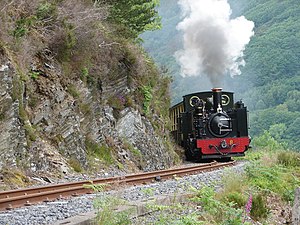Vale of Rheidol Railway
|
Rheilffordd Cwm Rheidol |
|
|---|---|
| Locomotive No. 8 Llywelyn on the climb to Devil's Bridge |
|
| Locale | Ceredigion, Wales |
| Terminus |
Aberystwyth Devil's Bridge |
| Coordinates | 52°24′40″N 4°04′45″W / 52.41114°N 4.07909°WCoordinates: 52°24′40″N 4°04′45″W / 52.41114°N 4.07909°W |
| Commercial operations | |
| Name | Vale of Rheidol Light Railway |
| Built by | Engineer: James Szlumper |
| Original gauge | 1 ft 11 1⁄2 in (597 mm) |
| Preserved operations | |
| Owned by | Phyllis Rampton Narrow Gauge Railway Trust |
| Operated by | Vale of Rheidol Railway Limited |
| Stations | 4 stations 5 halts |
| Length | 11 3⁄4 miles (18.91 km) |
| Preserved gauge | 1 ft 11 3⁄4 in (603 mm) |
| Commercial history | |
| Opened | August 1902 (freight only) 22 December 1902 (passenger) |
| 1913 | Taken over by Cambrian Railways |
| 1922 | Great Western Railway Grouping |
| 1948 | Became part of British Railways |
| 1968 | Became the last steam on British Rail |
| Preservation history | |
| 1989 | Privatised |
| Headquarters | Aberystwyth |
| Website | |
| www.rheidolrailway.co.uk | |
The Vale of Rheidol Railway (Welsh: Rheilffordd Cwm Rheidol) is a 1 ft 11 3⁄4 in (603 mm) narrow gauge heritage railway, opened in 1902, that runs for 11 3⁄4 miles (19 km) between Aberystwyth and Devil's Bridge in the county of Ceredigion, Wales.
From 1968 until 1989, when it was the first part of British Rail to be privatised, it was the sole steam-operated line on the 1948 nationalised British Rail network.
Unlike most other preserved railways in the United Kingdom, the Vale of Rheidol Railway did not have a period of closure between its operation as part of the national rail system and becoming a heritage railway, and has operated a service for tourists throughout its life.
A narrow gauge railway in the area of Aberystwyth was first proposed after the initial route planned for the Manchester and Milford Railway, from Llanidloes to Aberystwyth via Devil's Bridge, was altered, and then abandoned, before construction started.
The original primary purpose of the line was to carry timber (for pit props in the South Wales valleys) and lead ore from the Rheidol Valley to the sea and the main line railway at Aberystwyth. Many lead mines in the valley were producing ore at the end of the 19th century. Following an Act of Parliament in 1897, it was not possible to raise finance as quickly as expected, and construction commenced in 1901. To save money, rock was hand-hewn rather than blasted. Construction was overseen by the chief engineer, Sir James Szlumper, although he left day-to-day affairs in the hands of the main contractor employed. It was during construction that the ex-Plynlimon and Hafan Tramway locomotive Talybont, regauged from 2 ft 3 in (686 mm) to 1 ft 11 3⁄4 in (603 mm) and renamed Rheidol, arrived on the line, where it would remain for the rest of its life.
...
Wikipedia

